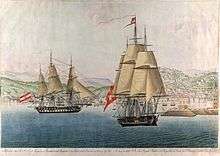Maria Leopoldina of Austria
| Maria Leopoldina of Austria | |||||
|---|---|---|---|---|---|
 Leopoldina at age 18, 1815 | |||||
| Empress consort of Brazil | |||||
| Tenure | 12 October 1822 – 11 December 1826 | ||||
| Queen consort of Portugal and the Algarves | |||||
| Tenure | 10 March 1826 – 2 May 1826 | ||||
| Born |
22 January 1797 Schönbrunn Palace, Vienna, Austria, Holy Roman Empire | ||||
| Died |
11 December 1826 (aged 29) São Cristóvão Palace, Rio de Janeiro, Empire of Brazil | ||||
| Burial |
1954 Monument to the Independence of Brazil, São Paulo, Brazil | ||||
| Spouse | Pedro I of Brazil | ||||
| Issue among others... |
Maria II of Portugal Princess Francisca Princess Paula Princess Januária Pedro II of Brazil | ||||
| |||||
| House | Habsburg-Lorraine | ||||
| Father | Francis II, Holy Roman Emperor | ||||
| Mother | Maria Teresa of Naples and Sicily | ||||
| Religion | Roman Catholicism | ||||
Dona Maria Leopoldina of Austria (22 January 1797 – 11 December 1826) was an archduchess of Austria, Empress consort of Brazil and Queen consort of Portugal.
She was born in Vienna, Austria, as the daughter of Holy Roman Emperor Francis II, and his second wife, Maria Teresa of Naples and Sicily. Among her many siblings were Emperor Ferdinand I of Austria and Marie Louise, Duchess of Parma, the wife of Napoleon Bonaparte. She was also the great-niece, through her paternal Grandfather, of the ill-fated Queen Marie Antoinette of France.
Early life
Leopoldine was born on 22 January 1797 in Schönbrunn Palace, in Vienna, Archduchy of Austria. She was given the name Leopoldine Caroline Josepha.[1]
She was raised in accordance with the educational principles laid down by her grandfather, Emperor Leopold II. Among these was the habit of exercising her handwriting by writing the following text:[2]
| “ | Do not oppress the poor. Be charitable. Do not complain about what God has given you, but improve your habits. We must strive earnestly to be good. | ” |
In addition, she and her sisters were taught to speak French and Latin. They were also educated in drawing, piano, riding and hunting.[2] Her mother died when she was ten years old and her father went on to remarry Maria Ludovika of Austria-Este. Her late mother was a soprano and Leopoldina had the chance of meeting Johann Wolfgang von Goethe in 1810 and 1812, when she went to Carlsbad with her stepmother.[2] Her passions included natural sciences, especially botany and mineralogy.[2] She was formed according to the three Habsburg principles: discipline, piety and a sense of duty.[2]
Although Maria Theresa of Naples and Sicily was her birth mother, Leopoldina always considered Maria Ludovika d'Este, her stepmother, to be her mother and she grew up with Ludovika as her "spiritual mother".[2]
Marriage to Pedro
On 24 September 1816 it was announced by Leopoldina's father that Pedro of Braganza wished to take a Habsburg princess as his wife.[3] Klemens von Metternich suggested that it should be Leopoldina to go get married, as it was "her turn" to become a wife.[4] Two ships were prepared and in April 1817 scientists, painters, gardeners and a taxidermist, all with assistants, travelled to Rio de Janeiro ahead of Leopoldina. Leopoldina, in the meantime, studied the history and geography of her future home and learned Portuguese. During these weeks Leopoldina compiled and wrote a vade mecum, a unique document the like of which has never been produced by any other Habsburg princess.[5]
On 13 May 1817 Leopoldina was married to Dom Pedro per procuram (by proxy) in Vienna. At the ceremony the bridegroom was represented by Leopoldina’s uncle, Archduke Charles. Embarkation took place in Livorno on 13 August 1817 among much celebration, and after an adventure-filled voyage lasting 81 days, Leopoldina arrived in Rio de Janeiro on 5 November and finally met her husband.[6]

From a distance Pedro initially appeared to Leopoldina to be a perfect, well-educated gentleman, but the reality was very different. Dom Pedro was a year younger than Leopoldina and sadly rarely measured up to the descriptions given by the matchmakers. His temperament was impulsive and choleric, and his education but modest. Even spoken communication between the young married couple proved difficult, as Pedro spoke very little French and his Portuguese could only be described as vulgar.[6]
In keeping with Portuguese tradition, at the age of eighteen Pedro of Braganza not only had a string of amorous adventures behind him and was principally interested in horse racing and love affairs, but in 1817 (the year of his marriage to Leopoldina) he was living as if in wedlock with French dancer Noemie Thierry, who was finally removed from the court by his father a month after Leopoldina's arrival in Rio de Janeiro.[6]
The young married couple took up residence in six relatively small rooms in the Palace of São Cristóvão. The inner courtyard and path to the stables were unpaved and the tropical rainfall quickly turned everything to mud. There were insects everywhere, including in their clothing, for the uniforms and court regalia made of velvet and plush rotted and turned mouldy in the heat and humidity.[6]
Empress of Brazil

Maria Leopoldina became Brazil's first empress consort. She also played an important role in the process of issuing a Declaration of Independence. On 2 September 1822, a new decree with demands from Lisbon arrived in Rio de Janeiro, while Prince Pedro was in São Paulo. Leopoldina, advised by José Bonifácio, and using her power as Princess Regent, met on 2 September 1822 with the Council of Ministers. She decided to send her husband the news along with a letter advising him to declare Brazil's independence and warned him, "The fruit is ready, it's time to harvest." Prince Pedro declared the country's independence upon receiving the letter on 7 September 1822.
When his father, João VI, died on 10 March 1826, Pedro inherited the Portuguese throne as King Pedro IV, while remaining Emperor Pedro I of Brazil. Maria Leopoldina thus became both Empress consort of Brazil and Queen consort of Portugal. However, two months later, Pedro was forced to give up the Portuguese throne to their seven-year-old daughter Maria.
At the end of November 1826, Pedro traveled to Cisplatina (now Uruguay) to join his soldiers. To mark the occasion there was a large farewell reception on 20 November 1826, and Pedro demanded that both women, Maria Leopoldina and his official mistress Domitila de Castro, Marchioness of Santos, appear together before the ecclesiastical and diplomatic dignitaries and receive his kiss on the hand. With the fulfillment of this demand, Maria Leopoldina would have officially recognized her husband's mistress, and for this she refused to appear at the reception. This caused a bitter argument with Pedro, who departed with no resolution to the situation.[7]
Shortly after, Maria Leopoldina became ill, had spells of fever, became delirious at times, and then suffered a miscarriage on 2 December 1826. She died eight days later, on 11 December, five weeks before her thirtieth birthday. She was buried on 14 December 1826 in Rio de Janeiro, in the church of the Ajuda Convent.[7]
Children
| Maria Leopoldina and her children |
|---|
 Empress Maria Leopoldina of Brazil with her children, by Domenico Failutti, 1921 |
| Name | Portrait | Lifespan | Notes |
|---|---|---|---|
| Maria II of Portugal | 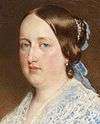 |
4 April 1819 – 15 November 1853 |
Queen of Portugal from 1826 until 1853. Maria II's first husband, Auguste de Beauharnais, 2nd Duke of Leuchtenberg, died a few months after the marriage. Her second husband was Prince Ferdinand of Saxe-Coburg and Gotha, who became King Dom Fernando II after the birth of their first child. She had eleven children from this marriage. Maria II was heir to her brother Pedro II as Princess Imperial until her exclusion from the Brazilian line of succession by law no. 91 of 30 October 1835.[8] |
| Miguel, Prince of Beira | 26 April 1820 | Prince of Beira from birth to his death. | |
| João Carlos, Prince of Beira | 6 March 1821 – 4 February 1822 |
Prince of Beira from birth to his death. | |
| Princess Januária of Brazil | 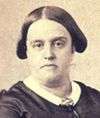 |
11 March 1822 – 13 March 1901 |
Married Prince Luigi, Count of Aquila, son of Don Francesco I, King of the Two Sicilies. She had four children from this marriage. Officially recognized as an Infanta of Portugal on 4 June 1822,[9] she was later considered excluded from the Portuguese line of succession after Brazil became independent.[10] |
| Princess Paula of Brazil | 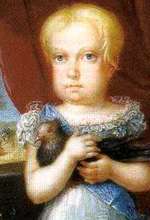 |
17 February 1823 – 16 January 1833 |
She died age 9, probably of meningitis.[11] Born in Brazil after its independence, Paula was excluded from the Portuguese line of succession.[12] |
| Princess Francisca of Brazil | 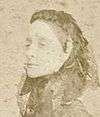 |
2 August 1824 – 27 March 1898 |
Married Prince François, Prince of Joinville, son of Louis Philippe I, King of the French. She had three children from this marriage. Born in Brazil after its independence, Francisca was excluded from the Portuguese line of succession.[13] |
| Pedro II of Brazil | 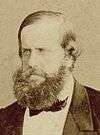 |
2 December 1825 – 5 December 1891 |
Emperor of Brazil from 1831 until 1889. He was married to Teresa Cristina of the Two Sicilies, daughter of Don Francesco I, King of the Two Sicilies. He had four children from this marriage. Born in Brazil after its independence, Pedro II was excluded from the Portuguese line of succession and did not become King Dom Pedro V of Portugal upon his father's abdication.[14] |
Titles and styles
- 22 January 1797 – 11 August 1804 Her Royal Highness Archduchess Maria Leopoldina of Austria
- 11 August 1804 – 6 November 1817 Her Imperial & Royal Highness Archduchess and Princess Imperial Maria Leopoldina of Austria, Princess Royal of Hungary and Bohemia
- 6 November 1817 – 12 October 1822 Her Imperial & Royal Highness the Princess Royal of the United Kingdom of Portugal, Brazil and the Algarves, Duchess of Braganza, Archduchess and Princess Imperial of Austria, Princess Royal of Hungary and Bohemia
- 12 October 1822 – 10 March 1826 Her Imperial Majesty the Empress of Brazil
- 10 March 1826 – 28 May 1826 Her Imperial & Most Faithful Majesty the Empress of Brazil, Queen of Portugal and the Algarves
- 28 May 1826 – 11 December 1826 Her Imperial Majesty The Empress of Brazil
Arms
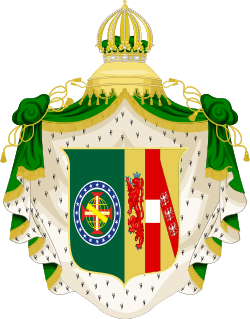 |
Ancestry
Footnotes
- ↑ Oberacker 1988, p. 31.
- 1 2 3 4 5 6 Schloß Schönbrunn (2010). "Leopoldine: Sunday's child". The World of the Habsburgs. habsburger.net. Retrieved March 9, 2012.
- ↑ Schloß Schönbrunn (2010). "1816 – A fateful year for Leopoldine". The World of the Habsburgs. habsburger.net. Retrieved March 9, 2012.
- ↑ Schloß Schönbrunn (2010). "An enquiry from Rio de Janeiro". The World of Habsburgs. habsburger.net. Retrieved March 9, 2012.
- ↑ Schloß Schönbrunn (2010). "An expedition to the tropics". The World of the Habsburgs. habsburger.net. Retrieved March 9, 2012.
- 1 2 3 4 Schloß Schönbrunn (2010). "A Portuguese fairy-tale prince?". The World of the Habsburgs. habsburger.net. Retrieved March 9, 2012.
- 1 2 Gloria Kaiser: Dona Leopoldina – Habsburg Princess, Empress of Brazil, 2009, p. 15 [retrieved 14 July 2015].
- ↑ Barman 1999, p. 438.
- ↑ Morato 1835, p. 17.
- ↑ Morato 1835, pp. 33–34.
- ↑ Barman 1999, p. 42.
- ↑ Morato 1835, pp. 17–18.
- ↑ Morato 1835, pp. 18–19, 34.
- ↑ Calmon 1975, p. 81.
References
- Oberacker, Carlos H. (1988). Leopoldine: Habsburgs Kaiserin von Brasilien (in German). Vienna/Munich: Amalthea. ISBN 3-85002-265-X.
- Barman, Roderick J. (1999). Citizen Emperor: Pedro II and the Making of Brazil, 1825–1891. Stanford, California: Stanford University Press.
- Morato, Francisco de Aragão (1835). Memória sobre a soccessão da coroa de Portugal, no caso de não haver descendentes de Sua Magestade Fidelíssima a rainha D. Maria II (in Portuguese). Lisbon: Typographia de Firmin Didot.
- Calmon, Pedro (1975). História de D. Pedro II (in Portuguese) 1–5. Rio de Janeiro: José Olímpio.
External links
| Wikimedia Commons has media related to Maria Leopoldina of Austria. |
- Article by Princess Michael of Kent about Leopoldine Retrieved 26 January 2006
| Maria Leopoldina of Austria Cadet branch of the House of Lorraine Born: 22 January 1797 Died: 11 December 1826 | ||
| Brazilian royalty | ||
|---|---|---|
| New title |
Empress consort of Brazil 12 October 1822 – 11 December 1826 |
Vacant Title next held by Amélie of Leuchtenberg |
| Portuguese royalty | ||
| Preceded by Carlota Joaquina of Spain |
Queen consort of Portugal and the Algarves 10 March 1826 – 2 May 1826 |
Succeeded by Auguste de Beauharnais as Prince consort |
